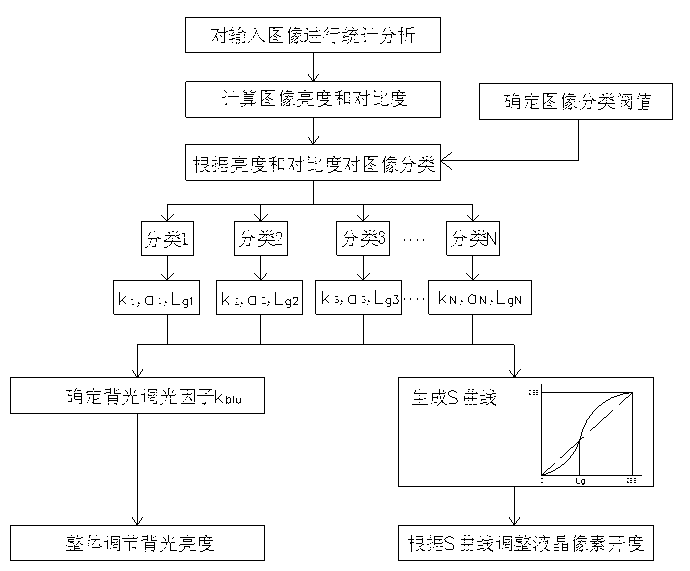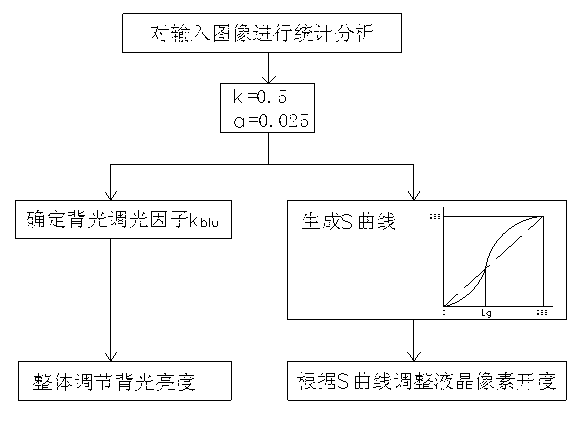Global dimming method of liquid crystal display backlight based on image classification
A global dimming, liquid crystal display technology, applied in static indicators, instruments, etc., can solve the problems of low contrast, limited application of dynamic dimming technology, and high power consumption
- Summary
- Abstract
- Description
- Claims
- Application Information
AI Technical Summary
Problems solved by technology
Method used
Image
Examples
Embodiment 1
[0046] Embodiment 1 divides images into 6 categories, namely, high brightness and high contrast, medium brightness and high contrast, low brightness and high contrast, high brightness and low contrast, medium brightness and low contrast, and low brightness and low contrast. The video source input is a standard definition image of 1024×768. Please refer to the specific dimming steps Figure 5 (d):
[0047] 1. Determine the number and threshold of image classification:
[0048] (1.1) Determine the number of image categories according to design requirements and hardware resources: Embodiment 1 divides images into 6 categories, namely, high brightness and high contrast, medium brightness and high contrast, low brightness and high contrast, high brightness and low contrast, medium brightness and low contrast, Low brightness and low contrast;
[0049] (1.2) Organize 6 natural persons with normal vision to watch 100 images with different contents, including day or night characters...
Embodiment 2
[0099] Embodiment 2 divides images into 6 categories, namely, high brightness and high contrast, medium brightness and high contrast, low brightness and high contrast, high brightness and low contrast, medium brightness and low contrast, and low brightness and low contrast. The classification thresholds of the six types of images have been obtained in Embodiment 1 and can be used repeatedly in Embodiment 2. The video source input is a high-definition image of 1920×1080. For the specific dimming steps of Embodiment 2, please refer to Figure 6 (c):
[0100] 1. Determine the number and threshold of image classification:
[0101] According to the design requirements and hardware resources, the image category is divided into 6 categories, namely, high brightness and high contrast, medium brightness and high contrast, low brightness and high contrast, high brightness and low contrast, medium brightness and low contrast, and low brightness and low contrast. In Embodiment 1, class...
Embodiment 3
[0136] Embodiment 3 divides images into 9 categories, namely high brightness and high contrast, medium brightness and high contrast, low brightness and high contrast, high brightness and medium contrast, medium brightness and medium contrast, low brightness and medium contrast, high brightness and low contrast, medium brightness and low contrast , Low brightness and low contrast. The video source input is a standard definition image of 1024×768. Please refer to the specific dimming steps Figure 7 (c):
[0137] 1. Determine the number and threshold of image classification:
[0138] (1.1) Determine the number of image categories according to design requirements and hardware resources: Embodiment 3 divides images into 9 categories, namely, high brightness and high contrast, medium brightness and high contrast, low brightness and high contrast, high brightness and medium contrast, medium brightness and medium contrast, Low brightness and medium contrast, high brightness and lo...
PUM
 Login to View More
Login to View More Abstract
Description
Claims
Application Information
 Login to View More
Login to View More - R&D
- Intellectual Property
- Life Sciences
- Materials
- Tech Scout
- Unparalleled Data Quality
- Higher Quality Content
- 60% Fewer Hallucinations
Browse by: Latest US Patents, China's latest patents, Technical Efficacy Thesaurus, Application Domain, Technology Topic, Popular Technical Reports.
© 2025 PatSnap. All rights reserved.Legal|Privacy policy|Modern Slavery Act Transparency Statement|Sitemap|About US| Contact US: help@patsnap.com



